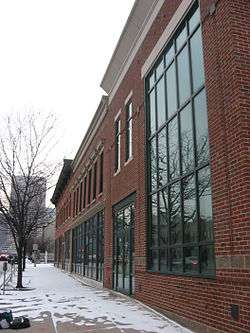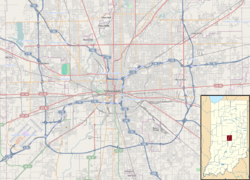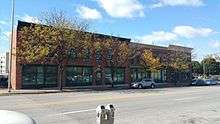Indiana Avenue
Indiana Avenue is a historic area in downtown and is one of seven designated cultural districts in Indianapolis, Indiana. Indiana Avenue was, during its glory days, an African American cultural center of the area.[2] The Indiana Avenue Historic District within the area was designated a United States national historic district in 1987.
Indiana Avenue Historic District | |
 New buildings in the Indiana Avenue Historic District | |
   | |
| Location | 500 block of Indiana Ave. between North St., Central Canal, Michigan, and West Sts., Indianapolis, Indiana |
|---|---|
| Coordinates | 39°46′29″N 86°9′57″W |
| Area | 3 acres (1.2 ha) |
| Built | 1869-1935 |
| Architectural style | Italianate |
| NRHP reference No. | 87000912[1] |
| Added to NRHP | June 12, 1987 |
History
In 1870, 974 African Americans (one third of the city's African American population) called Indiana Avenue home. This represented a shift in racial demographics away from the mostly working class poor population of Irish and German immigrants that lived around Indiana Avenue during the early years of Indianapolis.[3] As the African American population increased, black entrepreneurs opened businesses on practically every corner. Bethel AME (African Methodist Episcopal) Church, the oldest African American congregation in Indianapolis, was organized in 1836.[4] African American owned businesses opened on the Avenue by at least by 1865, including a grocery store owned by Samuel G. Smothers and a "peddler shop" owned by William Franklin.[5][6] The Indianapolis Leader, the first black owned newspaper in Indianapolis, catered to the interests of the growing African American population and featured advertisements for Indiana Avenue businesses.The Indianapolis Leader began publishing in the 1870s.[7]
The avenue continued to culturally develop, in much the same way as the Harlem Renaissance. Due to the nature of segregation and Jim Crow laws, several streets developed similarly in other cities, including Beale Street in Memphis and 12th and Vine in Kansas City according to the book, Indiana Avenue: Black Entertainment Boulevard by C. Nickerson Bolden. Like Indiana Avenue, these streets were called Black Entertainment Bouelvards, or stops along the Chitlin' Circuit because of the large concentration of black-oriented clubs, businesses and entertainment venues.
Many prominent historical figures have their roots on Indiana Avenue: Madam C.J. Walker, jazz greats including Freddie Hubbard, Jimmy Coe, Noble Sissle, Erroll "Groundhog" Grandy and Wes Montgomery.[8] Mary Ellen Cable was one of the most important African American educators in Indianapolis. Coupled with her great work as an educator, she organized and served as the first president of Indiana's NAACP chapter.[9][10]
Madame Walker Theatre
Madame Walker's daughter helped build the Madame Walker Theatre, which opened on the Avenue in 1927 and quickly became known as the "Crown Jewel of the Avenue".

The decline of the Avenue

As segregation laws began to change in the late 1950s, the African American middle class began leaving the once bustling Indiana Avenue corridor for greater opportunities in northwestern Marion County, settling in Pike and Washington Townships. By 1965, the plight of the community left the Madame Walker Building closed to abandonment, removing a vital economic anchor for the area. The Walker Manufacturing Company remained in the ailing Building. By the early 1970s, Indiana Avenue was suffering from severe urban blight.
Historic district and revival
By the 1980s, instead of the city attempting renewal or regeneration, much of the area was demolished and replaced by office buildings or townhouses. In 1987, the area, containing eleven historic buildings, was declared a United States national historic district.[11] The district was developed between about 1869 and 1935, and includes representative examples of Italianate style architecture.[12]The Madame Walker Building, one of the historic buildings, was restored and reopened to the public in 1988 with a focus on the performing arts.
Through the financial support of the Indianapolis Cultural Development Commission, formed by Mayor Bart Peterson in 2002, community stakeholders are planning the regeneration of the area. On March 28, 2007, the name of Indiana Avenue north of 10th Street and south of 16th Street was restored, after having been called Stadium Drive since 1932.[13]
References
- "National Register Information System". National Register of Historic Places. National Park Service. March 13, 2009.
- Hale, Michelle (1994). The Encyclopedia of Indianapolis. Bloomington and Indianapolis: Indiana University Press. pp. 729–732. ISBN 0253312221.
- Hale, Michelle (1994). The Encyclopedia of Indianapolis. Bloomington and Indianapolis: Indiana University Press. pp. 729–730. ISBN 0253312221.
- Hale, Michelle (1994). The Encyclopedia of Indianapolis. Bloomington and Indianapolis: Indiana University Press. pp. 318–319. ISBN 0253312221.
- Hale, Michelle (1994). The Encyclopedia of Indianapolis. Bloomington and Indianapolis: Indiana University Press. p. 730. ISBN 0253312221.
- "Discovering Indiana Avenue". Archived from the original on 2007-11-19. Retrieved 2007-11-19.
- Hale, Michelle (1994). The Encyclopedia of Indianapolis. Bloomington and Indianapolis: Indiana University Press. p. 730. ISBN 0253312221.
- Baker, David (1994). The Encyclopedia of Indianapolis. Bloomington and Indianapolis: Indiana University Press. pp. 841–841. ISBN 0253312221.
- "IUPUI Diversity Assets" (PDF). National Park Service. 2006-11-02.
- "Indiana Humanities.org". Archived from the original on 2007-10-09. Retrieved 2007-11-19.
- National Park Service (June 19, 1987), Weekly announcement of National Register of Historic Places actions (PDF), pp. 62-63, archived (PDF) from the original on October 10, 2017, retrieved May 6, 2018.
- "Indiana State Historic Architectural and Archaeological Research Database (SHAARD)" (Searchable database). Department of Natural Resources, Division of Historic Preservation and Archaeology. Retrieved 2016-08-01. Note: This includes F. Eric Utz; Suzanne T. Rollins; William Gulde (August 1986). "National Register of Historic Places Inventory Nomination Form: Indiana Avenue Historic District" (PDF). Retrieved 2016-08-01. and Accompanying photographs
- "Inside Indiana Business". 2007-03-28.